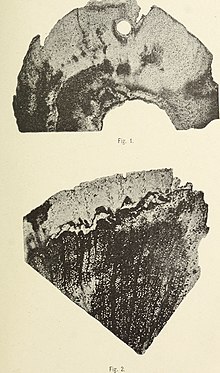Nicolia (genus)
| Nicolia | |
|---|---|

| |
| Cross-sections of fossilized specimens of N. moresneti from the Aachen Formation | |
| Scientific classification | |
| Kingdom: | Plantae |
| Clade: | Tracheophytes |
| Clade: | Angiosperms |
| Genus: | †Nicolia Unger, 1842 |
| Species: | †N. aegyptiaca |
| Binomial name | |
| †Nicolia aegyptiaca Unger, 1842 | |
| Other species | |
| |
| Synonyms | |
Nicolia is a genus of fossilized wood from the Late Cretaceous to Pleistocene of Belgium,[2] Ethiopia, Egypt, New Caledonia,[3] New Zealand, and Tunisia.[1] The type species is N. aegyptiaca.[1][4]
Discovery and naming
The type species Nicolia aegyptiaca were named in 1842 by Franz Unger.[5] The first specimens were collected in Egypt and it is often synonymised with Sterculioxylon aegypticum.[6]
The discovery of N. caledonica suggests the genus existed until the Pleistocene.[3]
Aachenosaurus
Independently in 1887, the name Aachenosaurus was created by the scientist (and abbé) Gerard Smets based on fossilized fragments found in the Aachen Formation of Moresnet (which was a neutral territory between Belgium and Germany).[2] Smets considered that the specimen was a hadrosaur reaching an estimated 4 to 5 meters in length which might have had dermal spines.[2] He defended this conclusion, citing that the fossils had been examined visually with the naked eye, magnifying lenses and with the microscope. However, his error was soon demonstrated by Louis Dollo. Smets at first tried to defend his original identification but was again proven wrong by a neutral commission.
Aachenosaurus has since been considered to be a synonym of Nicolia moresneti.[1]
A synonym of Aachenosaurus is Aachenoxylon, which was coined by Dr Maurice Hovelacque in 1889/1890.[7][8][9]
Species
- Nicolia aegyptiaca (Type species) — Late Cretaceous of Egypt[4][5][6]
- Nicolia caledonica — Pleistocene of Ducos Island, New Caledonia[3]
- Nicolia moresneti — Late Cretaceous of Belgium[4][5]
- Nicolia tunetana — Pliocene of Tunisia[3]
- Nicolia zealandica? — Cenozoic of New Zealand.[5] Its placement within Nicolia has been questioned.[6]
Previously assigned species
- Nicolia giarabubensis (now Sterculioxylon giarabubense) — Oligocene of Egypt (Fayyum)
- Nicolia minor (now Bombacoxylon owenii)[4]
- Nicolia oweni (now Bombacoxylon owenii)[4]
- Nicolia wiedemanni (now Sterculioxylon aegyptiacum) — Egypt
References
- ^ a b c d "Nicolia". Global Biodiversity Information Facility. Retrieved 1 October 2022.
- ^ a b c Smets, G. (1888). "Aachenosaurus multidens". Bulletin de la Société belge de géologie, de paléontologie et d'hydrologie. 12 (2). Bruxelles: The society: 300 – via Biodiversity Heritage Library.
- ^ a b c d Crié, L (1899). "Beiträge zur Kenntniss der fossilen Flora einiger Inseln des Südpacifischen und Indischen Oceans". Palaeontologische Abhandlungen. 1=5 (2): 81.
- ^ a b c d e H. N. Andrews. (1970). Index of Generic Names of Fossil Plants, 1820-1965. Geological Survey Bulletin 1-354
- ^ a b c d Unger, F. (1842). Synopsis Lignorum Fossilium Plantarum Acramphibryarum. In Endlicher Genera Plantarum Suppl. II, Appendix, pp. 100—102.
- ^ a b c Édouard Boureau. (1949). Étude paléoxylologique du Sahara (VI). Sur une forme nouvelle de Sterculioxylon (Nicolia) aegyptiacum (Unger) Krausel, des couches post-éocènes du Tibesti, Bull. Mus. Nat. Hist. Paris ser. 2, 21(6): 776-787
- ^ "Aachenoxylon". Retrieved 7 March 2020.
- ^ H., G.F. (1891). "IV.—Sur la nature Végétale de l'Aachenosaurus multidens, G. Smets. Par DrMaurice Hovelacque (Mem. Soc. Belge de Géol. iv. (1890) p. 59 et seq.)". Geological Magazine. 8 (2). Cambridge University Press: 82–83. Bibcode:1891GeoM....8...82G. doi:10.1017/S0016756800185504.
- ^ Stopes, M.C. (1913). Catalogue of the Mesozoic plants in the British museum (Natural history) The Cretaceous flora. Vol. 5. p. 39.
External links
